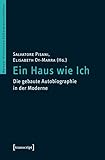Ein Haus wie Ich : Die gebaute Autobiographie in der Moderne / hrsg. von Elisabeth Oy-Marra, Salvatore Pisani.
Material type: TextSeries: Mainzer Historische Kulturwissenschaften ; 14Publisher: Bielefeld : transcript Verlag, [2014]Copyright date: ©2014Edition: 1. AuflDescription: 1 online resource (312 p.)Content type:
TextSeries: Mainzer Historische Kulturwissenschaften ; 14Publisher: Bielefeld : transcript Verlag, [2014]Copyright date: ©2014Edition: 1. AuflDescription: 1 online resource (312 p.)Content type: - 9783837622225
- 9783839422229
- 720.1 22/ger
- NA7349
- online - DeGruyter
| Item type | Current library | Call number | URL | Status | Notes | Barcode | |
|---|---|---|---|---|---|---|---|
 eBook
eBook
|
Biblioteca "Angelicum" Pont. Univ. S.Tommaso d'Aquino Nuvola online | online - DeGruyter (Browse shelf(Opens below)) | Online access | Not for loan (Accesso limitato) | Accesso per gli utenti autorizzati / Access for authorized users | (dgr)9783839422229 |
Browsing Biblioteca "Angelicum" Pont. Univ. S.Tommaso d'Aquino shelves, Shelving location: Nuvola online Close shelf browser (Hides shelf browser)
restricted access online access with authorization star
http://purl.org/coar/access_right/c_16ec
Selbstthematisierung und Selbstreflexion haben ihren klassischen Ort in Tagebuch, Memoiren und Brief. In der Moderne jedoch wird verstärkt das Haus als »Abdruck seines Bewohners« (Walter Benjamin) erkannt, was von einer neuen privilegierten Entäußerungsform des Ich in der Architektur zeugt.In diesem interdisziplinären Sammelband wird ein ebenso vielfältiges wie spannendes Bild davon entworfen, wie Sprache und Subjekt ihr Territorium auf das Haus ausdehnen und wie sich life writing und life building ergänzen. Ein Fazit, das alle Beiträge eint und sich erstaunlich vormodern liest: Das Ich bewohnt ein Haus, aber das Haus bewohnt auch das Ich.
The classical places for the self as a subject of reflection are diaries, memoirs, and letters. But in the modern age, the house is increasingly recognized as an "imprint of its inhabitant" ("Abdruck seines Bewohners", Walter Benjamin). This points towards a new, privileged form of expropriation of the ego in architecture. In this interdisciplinary anthology, a very diverse and exciting picture is drawn of how language and subject expand their territory to include the house, and how life writing and life building complement each other. A conclusion that unites all the contributions and that reads surprisingly pre-modern: The ego inhabits a house, but the house also inhabits the ego.
Mode of access: Internet via World Wide Web.
In German.
Description based on online resource; title from PDF title page (publisher's Web site, viewed 01. Nov 2023)









